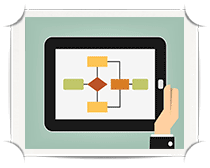 When designing an eLearning course to boost your client’s sales performance, what is the first step that comes to your mind?
When designing an eLearning course to boost your client’s sales performance, what is the first step that comes to your mind?
A. Who are the sales persons? How do I create training to teach them to sell better?
B. What is the client’s sales expectation in a given quarter or a month?
What option did you select?
We are dreading, most instruction designers (ID) and eLearning developers have selected option A. If you did, we don’t blame you. While your intentions are good for your learners, you may not earn many laurels from your client!
Option A signifies the need to create learner-centered material. All your adult learning theories that you “experted” over the years, pretty much boil down to creating constructivist or learner-focused training materials.
While this strategy is worth its weight in gold, in many circumstances, in particular sales, training will NOT benefit from your option A strategy.
Ditch the “save the vulnerable learner” hat and wear a new one – the “client sales KPI” hat. KPI is the rising buzz word in eLearning strategy development. Key Performance Indicators or Key Success Indicators are those hard facts and figures that distinctly portray the performance and turnover expectations of the client from their organization.
Let’s dig deeper into KPIs and discover how we can relate them to potential sales training.
What’s KPI anyway?
“KPIs evaluate the success of an organization or of a particular activity in which it engages. Often, success is simply the repeated, periodic achievement of some levels of operational goal (e.g. zero defects, 10/10 customer satisfaction, etc.), and sometimes success is defined in terms of making progress toward strategic goals” (Wikipedia).
Recall that all training programs within an organization are intimately tied with its operational and strategic goals.
Which simply means that if you had chosen option B above, you would have received a bingo from us! The client’s expectations from sales performance in a given month or a quarter translates into certain KPI’s that your training needs to fulfill.
Sales KPI’s have made your life easier.
Why on earth do I need to bother with KPI’s to design a sales training for sales people?
Take a deep breath and bite the bullet!
For starters, sales training is not as simple as “customer satisfaction rating” anymore. Communications technology and CRM (Customer Relationship Management) interfaces have diversified into several functionalities.
Each requiring its own training. Each accompanied with concrete KPIs’.
Second, and even more important than the first, the client is paying you for your services to them, not to the learner. Your credibility as an expert eLearning developer is sensed as soon as you accelerate the KPI’s numbers. Trust us, this is as simple as daunting as it sounds!
In an ideal world, you build eLearning courses that are aligned with the client’s and learner’s needs.
However, in the realm of sales, your client is trying to achieve specific objectives. Your task is to create training materials that enable the client to achieve these objectives. Once you are able to define these objectives clearly, you will ultimately be able to create a course that engages your learner.
Discussing the client’s sales KPIs is a sure-fire method to grab the “bottom line” of the client expectations. The best part about developing a sales training-based on KPIs, it is being able to measure the impact of your training and plan its momentum in future courses.
Don’t we all want to under-promise and over-deliver?
Get into the client’s KPIs and you have the IT factor to raise the sales bar! The moment your training raises the KPI figures, you can be assured of a solid fan-base in your client’s organization.
Before you know it, you have a whole new series of sales training proposed to a very eager client!
How do I begin? Where do I begin?
Relax! Simply do what you usually do: analyze the performance gap. In the sales training scenario, measure the current performance level of the sales team. Compare it with the client’s performance expectations.
Here are the different sales KPIs generally calculated for a sales department:
- New customer acquisition.
- Demographic analysis of individuals (potential customers) applying to become customers, and the levels of approval, rejections, and pending numbers
- Status of existing customers
- Customer attrition
- Turnover (i.e., revenue) generated by segments of the customer population
- Outstanding balances held by segments of customers and terms of payment
- Collection of bad debts within customer relationships
- Profitability of customers by demographic segments and segmentation of customers by profitability
Notice each sales specification will be related to a number – an indicator of the performance in the area.
For example, the client may ask you that their expectation from your training material is to be able to raise the new customer acquisition from 8 per month to 15.
How would you accomplish that? Take notes of the current business process and determine scaffolding stimulators that will yield more customers per month.
The profitability of customers by demographic segments is again a very strong training material topic. Each customer demographic would be associated with their purchase behavior and other analytics.
Understanding each segment and dealing with it uniquely would improve sales and transaction experiences between sales staff and customers.
Improving the KPI for each customer segment will be your ultimate training goal. Simply measure the KPI figures during the pre and post-training period.
The CRM software will provide you with several “state-of-affairs” observations. Tap into this data to determine current performance level, analyze gaps and determine the best route to achieve the KPI for the particular sales area.
Performance gap needs to be converted into your new sales enablement venture.
Good luck. Remember to measure your training impact using statistical inferences and graphs to present in your portfolio to your future clients.
Let us know your experiences in the comments section right below!
| Tags: Sales Training


Leave a Reply